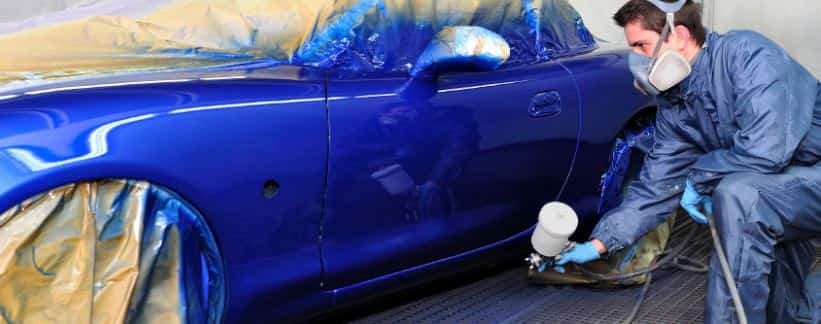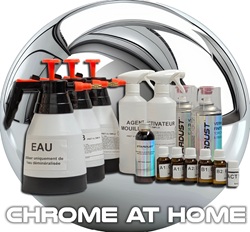 What theories to know to be able to apply a painting ?
What theories to know to be able to apply a painting ?
When you are a professional painter, you have a lot of knowledge and you are supposed to know everything by heart techniques for applying paint to bodywork. When you are not an experienced painter, you can acquire the minimum and sufficient knowledge to accomplish a touch-up or a personalized decoration, by reading the label present on the product and if possible by reading the technical data sheet, and also from the product sheet, which details the characteristics and instructions for implementation.
There are several areas of knowledge and theoretical knowledge that revolve around the profession of automotive painting. The first concerns spraying techniques :
How does a spray gun work ? Know the differences between classic guns and the new HVLP guns, as well as the different settings...
Know the right method of application, with the right distance to the support, the angle of the gun, the pressure and the debit. Know how to adapt all these parameters, according to the type of products to be sprayed. And of course there is also the disassembly, cleaning and reassembly of the tools.
Knowledge of the products, their nature and their composition, their compatibility, their preparation and their mixing... All this constitutes the second major pole of theoretical knowledge. This is the information that one acquires during one's school career, but not completely, because this is a mountain of knowledge to accumulate and acquire during real work, that is to say the experience at day by day, with the implementation of very many different products.
There are paints, primers, varnishes, hardeners, degreasers, additives, cleaners... It is important to strictly follow the instructions for use of each product. Water-based or solvent-based paints behave quite differently when applied.
Their blend and shelf life are just as different. Regarding varnishes, there are a large number of them, there are bad ones and excellent ones. In general, each refinisher has a favorite varnish that he likes to use first, because he knows it well and masters it perfectly. There are also varnishes for each use, for example to obtain ultra-fast drying and without baking, in order to be able to free up a paint booth.
The theoretical knowledge to master before using a paint
The adhesion and covering techniques represent a very important point for the painter. It's not just about knowing how to handle a spray gun and mixing paint perfectly, to ensure the success of a painting project.
In the world of bodywork, we talk about of “paint system” : this means that a paint is a set of coherent and compatible layers. One of the most important things to know is how to weld each layer of this mille-feuille, so that they cling perfectly together. This can be achieved by a "wet on wet" grip before the superficial drying time or generally by sanding.
In bodywork CAP training, a large part of the time is devoted to dent removal and repairs to the metal surfaces of vehicles. There is a certain amount of theoretical knowledge on how to straighten or remove surface imperfections after shocks or scratches.
Finally, there are the special painting techniques for personalization which are probably the most numerous, the most original and the most complex at times.
These are mainly techniques for superimposing adhesive marking, spraying colors and solids. This requires a lot of patience and a lot of attention to detail. One cannot imagine the potential of different possible combinations. The many modern products are very innovative and they multiply the possibilities in terms of colors and visual effects.
Techniques with airbrushing, freehand drawing and "flying stencil" techniques constitute a whole field of decorative art, which we invite you to discover, looking at the works of the best artists specializing in airbrushing.
 The rules of the art of bodywork painting
The rules of the art of bodywork painting
There are a number of basic rules, carved in stone, which are the foundations of body painting and are referred to as the rules of the art of bodywork painting. In an article dedicated to this subject, we develop all the depth and the importance of this simple sentence or basic rule which constitutes the cornerstone of the profession of painter on vehicles. Whoever knows and applies these rules to the letter ensures success in all these projects. It is also a way to make the "guaranteed" creations more resistant and durable over time, avoiding all defects and problems of detachment or fragility.
Training in the field of painting
When a young person wishes to become a coachbuilder or body painter, the normal course for training in the field of painting is done after the third class in college, with a two-year apprenticeship course in CFA, which leads to obtaining a CAP. It is also possible for an adult to train in one year, with the qualifying training of "Repair Bodybuilder" offered by the AFPA.
It is perfectly possible to obtain all the basic theoretical and practical knowledge, during courses offered in adult education and the training year, which includes five two-week courses.
Painting defects and resolution
When painting bodywork, it is common to be confronted with problems of reaction or result after application. Knowing paint defects and solving them is what makes the difference between theoretical and academic knowledge on the one hand, and concrete practical experience on the other.
Most of the very big paint brands offer guides to the various faults, reactions and corrective solutions for each case.
It is first of all important to know the cause of the fault and this is sometimes complex. If one does not understand what caused the fault, then it is not reasonable to start the application again in the same way.
Then there is an optimal and intelligent way to repair these faulty areas or to redo the paint partially or totally.




















































































